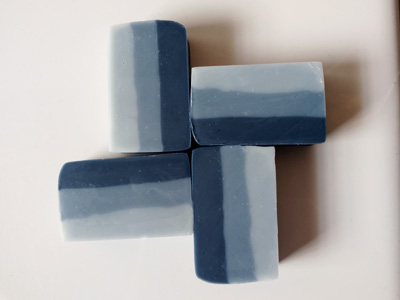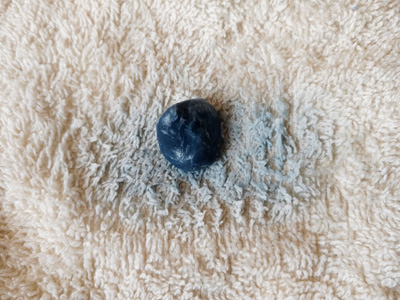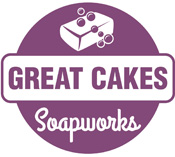How to Use Indigo to Color Cold Process Soap

If you’ve ever tried to use indigo to color your cold process soap and ended up with a nasty gray – or worse yet, no color at all – this post is for you! I’ve been there too, which is what drove me to figure out the best ways to get a beautiful color – from a light grayish blue to beautiful teal to dark navy blue. But what about color transfer and colored lather? Can you use too much? Definitely!
It should be noted that there are different types and intensities of indigo available from different suppliers and they are used in different ways. I will show you the benefits and disadvantages of each.
Let’s start with the different types. There are two different types of indigo: powdered and pre-reduced crystals. You can purchase the powdered form from several reputable soap supply vendors. (Thanks to the samples provided by Amanda Gail of Lovin Soap, I tested powders from Bramble Berry and From Nature With Love.) The only supplier of the crystals that I could find is Dharma Trading.
There are also different intensities of indigo powder. In addition to the powders from Bramble Berry and From Nature With Love, I tested a powder from Botanical Colors. They are not a soap supplier, but market their products to those who dye fabrics. It is an organic indigo powder that is much more saturated than the ones I tested from the soap suppliers.
I experimented with four different ways of incorporating indigo in cold process soap. 1. adding it to the hot lye solution, 2. creating strong oil infusions and adding after the soap was mixed, 3. dissolving the crystals in hot water, allowing it to cool and adding it after the soap was mixed, and 4. incorporating an oil infusion in addition to soap that already had indigo added to the lye solution. The powdered indigo can be added either to the lye solution OR in an oil infusion, but the pre-reduced crystals must be dissolved in hot water.
It’s important to use a soap recipe with light colored oils so that it doesn’t yellow and turn what could have been a lovely blue soap into an icky green or brown. I also made sure every batch went through gel stage to brighten/darken the colors. In a couple cases, the soap only reached a partial gel. This is the recipe I chose for all of my testing:
33% tallow
33% avocado
30% coconut
4% castor
5% superfat
30% lye concentration
Experiment #1: Testing saturation levels with the organic indigo from Botanical Colors using oil infusions.

The colors are grayish blue, just as they should be! I was worried that the darkest layer might bleed, so I did some testing on a cream-colored wash cloth:

I love that you can treat this indigo just like mica by pre-mixing it with a bit of oil and adding it to portions of soap. It makes it easy to do design work. However, the indigo takes a bit longer to incorporate than mica, so it requires you to plan ahead at least a few hours before you want to make the soap.
Experiment #2: Testing organic indigo and pre-reduced indigo crystals in the lye solution.
I used 1/2 tsp of indigo in both lye solutions for the same size batch (16 oz of oils). The powdered organic indigo is pictured on the left, and the pre-reduced crystals are on the right in the following photos:




The results of this test are rather stunning! The organic indigo remained a very dark blue – even darker than the darkest layer of the oil infused soap, while using almost half the amount.

This begs the question whether the lather of this super dark blue soap would stain the cream-colored washcloth:

The soap colored with the crystals also came out beautifully – a very lovely dark greenish blue, with a lighter teal green around the outside. I think this may have happened because I put this soap in the oven to force gel stage and the heat pushed the green plant material to the outside. Just a theory though.

And the color bleed test:

The advantage to using this method is the ability to use much less colorant to get a strong color. The disadvantage is that you can’t do any design work. Your soap will be all one color – all one very lovely color though! I would also advise mixing the lye solution in a stainless steel container instead of plastic, as the indigo has now permanently stained the plastic measuring cups.
Experiment #3: Testing indigo powders from Bramble Berry and From Nature With Love using oil infusions.
I could tell just by looking at the color of the powders from these two different suppliers that the results from this experiment would be different.

For this batch, I made 4 cups of soap (24 oz. of oils). Each oil infusion was made with 1 teaspoon of avocado oil mixed with the following amounts of indigo powder:

Experiment #4: Testing pre-reduced indigo crystals dissolved in water added at trace.
For this experiment, I boiled 1/8 cup of water in the microwave, then added 1/8 tsp. of pre-reduced indigo crystals and stirred to dissolve. This method still puts off an odor, by the way! This time I made a batch of soap with 16 oz. of oils and poured off 1/2 cup of soap to add 1/4 tsp. of white kaolin clay dispersed in water for some drop swirls (just to add a design element). I took photos of the remaining soap batter after adding increments of 2.5 ml of the indigo solution:

Once I had 10 ml of indigo solution added, I was happy with the color and poured the soap into the mold, adding the white drop swirls. Instead of putting the soap in the oven, I put it on a heating pad and covered it with towels. This produced a partial gel phase, and you can see the difference in color between the soap that didn’t gel and the soap that did:

Isn’t it the most beautiful Tiffany blue? I just love how it turned out! I also observed that there is some shadowing around the white drop swirls – possibly due to the migration of the water that dispersed the clay or indigo, I’m not sure which. The other observation is the white outline around the outside of this soap, similar to the outline around the soap made with the crystals in the lye solution. Now I’m starting to think it’s because both of these soaps were made in a mold lined with silicone instead of freezer paper.
I thought I was finished now, but after seeing the results of Experiment #4, I knew I had to try one more batch using the indigo powder from Bramble Berry in the lye solution to see if I could get a nice blue color.
Experiment #5: Testing indigo powder from Bramble Berry in the lye solution.
Instead of adding the powder straight into the hot lye solution, I heated up the distilled water and mixed the powder into the hot water first. I had to cool it down in a cold water bath in my sink before adding the lye. It took an extra step to cool the water down twice, but the powder seemed to incorporate better this way. As soon as the lye was mixed in, the indigo turned a bit green, but you can see that after pouring the solution into the oils, there wasn’t as much residue left:

Again, this batch size was 16 oz. of oils and I wanted to try one more thing to boost the blue color – layering more colorant into a portion of the soap by adding an oil infusion. I poured off 1 cup of soap and added an oil infusion of 1/2 tsp of indigo mixed with some avocado oil. Here you can see the difference in the color of the raw soap batter:

And the final soap:

I can see how layering different amounts of oil infusion on top of a soap that is already colored with indigo in the lye solution could produce some beautiful designs!
In case you are wondering if that dark soap will bleed:

Here’s one final comparison photo of the soaps made with 1/2 tsp of powder or crystals in the lye solution of a soap batch size with 16 ounces of oils:

This has been quite learning experience! I’ve discovered that not all indigo colorants are the same, and that you can achieve different colors and shades using different methods of incorporating the indigo into the soap. I have much more confidence in my ability to color soap naturally with indigo, and I hope you will too!

Page with Comments
Comments are closed.

This was incredibly informative, Amy! Thank you for taking the time to do these experiments and sharing them! ☺️
Amy! It’s so funny that you should share this post today. I actually made a batch of soap this morning with BB Indigo powder. First time for me and I did it because I pulled up you’re pic of the above soap in my Pinterest board. And you’re right, it was greenish blue in the lye pot. I added mine when the lye had cooled at 1 TBS to 36 OZ of oil. When I checked on it later it had turned green albeit this is my recipe with mostly really light oils. Now it’s turning back to a light blue/grey. I’m Pinning this for future reference! Thanks a lot!
Thanks Amy indigo is on my shopping list I have not used it and now I know I really need to think about it and have so many choice Happy happy!
Hi Amy,
Thank you for doing all of this research. So helpful! You missed a possible color though: pink! I had figured this out the hard way last winter when I needed a sky blue and managed a light pink instead. I thought I had done something wrong until I read Holly from Kapia Mera’s impression mat blog post: https://kapiamera.blog/2015/12/17/sweet-heart-soap/
My goodness that was a lot of work! Thank you so much for so carefully documenting your procedures and results, and most of all for sharing with us. 🙂
Very interesting! Thanks for doing all this testing. I have had little experience with indigo, but it’s pretty when done well.
Fantastic info! Thank you Amy! I was going try my indigo also. Mine is from Soap making resource, so I am curious how it will compare. I learned alot from tor examples on how to test different aspects . :))
Excellent work, Amy. Thank you for running this experiment and sharing the results.
@Janie – Oh yes!! I do remember this! Thank you for posting the link here!
@Eva – Make sure you check out the link Janie posted in her comment on how Holly uses the indigo from Soap Making Resource!
Thank you Thank you…I once made some CP by adding the indigo to lye water. Turned dark gray. This information is GREAT. Thank you Amy!
Thanks Amy, very nice comparison. I’ve used indigo powder that I got as a free sample from Soap Making Resource before. I just premixed it in oil and used as if I would an oxide or mica and I got a nice blue jean color. Just something I wanted to share is that I did notice that the color of the bar did fade in the light just like a pair of jeans over time. I tried to attach a picture from my iPad, but no luck, sorry!
@Vicki – Thanks for this! I think the main lesson I learned is that not all indigos are the same, and it’s good to know what you are working with before you create something! 🙂
Hi, I tried twice to color soap with indigo and failed. Once it almost disappeared and second, it stayed green. Is it the powder of the plant Indigofera tinctoria you used in these experiments? And can you also tell me how did you make the oil infusion? Just prepared it before adding to the soap or let it sit for a while?
@Catalina – Thanks for your comment! I believe different suppliers have different qualities of indigo powder and none of them really give any more information about what they are selling other than powder vs. crystals. The only information I have is what the supplies give, so if you see something that looks like the outcome you’d like to have, order from that supplier! The oil infusion was just prepared right before adding it to the soap.
Hey, I’m a chemist that works with indigo extensively. I also make soap in my spare time, so I can explain some of the things you have observed. First off, most indigo you can buy is not derived from plants. It is a synthetic colorant and unless the website specifically states that it is plant-derived, most likely this is what you are getting. Indigo is insoluble in water, and will only be sparingly soluble in most oils, though for soap making you can get away with grinding it very finely and making a suspension in oil. Indigo is applied to fabric by reducing it to a water-soluble form, which is green, dipping the fabric into the dye solution, and then pulling it out and allowing it to oxidize in air back to blue. The pre-reduced indigo is dried in the green reduced form along with some extra reducing agents. This is why it made a strong-smelling green solution- you essentially made a really really strong dye vat, and the reducing agents used with indigo are pretty stinky. Over time, your teal soap will likely become much bluer as the indigo slowly finishes oxidizing.
The natural indigo you can buy online is largely fairly low purity, which explains a lot of the greens/greys people get when using it in soapmaking.
I have noticed that indigo in soap fades very quickly. The pink color in the soap is most likely due to indirubin, a red chemical that is present in both natural and synthetic indigo and is formed as a by-product in both pathways. When I use indigo in my soap, I try to aim for the pink color, since it seems to be much longer-lasting.
In my opinion, if you want a lasting blue soap you should use a mica.
This is so fascinating, Laurel!! Thank you for sharing your knowledge!!
Thanks all for clarifications. I know my indigo is organic from a plant but I see that what is giving blue color to the soap may be synthetic. So I.ll start to use mica, no more indigo experiments 🙂
Thank you so very much for taking the time to post your experiments. I am using crystals now but was wondering how other indigo’s behaved. Excellent post! Awesome.
Hi again!
I’ve recently been revisiting indigo soap using maya blue, which is a pigment made with indigo and a specific type of clay. Still testing the permanence of the bright blue colors, but it looks really promising. You can find a couple of recipes for maya blue online.
I recommend adding the pigment to the oil and blending it a bit before adding the lye.
@Laurel – Thanks so much for this info!!
Thank you for taking the time to experiment so systematically and document everything for the rest of us! I’m excited to try indigo in my soap soon 🙂
Amy or @Laurel or anyone,
HELP!
I bought “100%” “natural” “pure” indigo leaf powder (a green colored-powder) at an Indian market. The box says “external use,” “for hair.”
Using light oils I made CP soap with 1 TSP indigo powder/1PPO. I was sure it would come out green – it did. It’s still green days after cutting.
During the next three hours, I added indigo powder to hot tap water, hot distilled water, to lye-water, I re-heated the tap water, and infused it in coconut oil for 2.5 hours.
Then I dipped paper towels in all my test containers and they were mostly no color.
Only one time with hot tap water could I produce a beautiful array of deep dark – to – light array of indigo color on the napkin. I have yet to repeat this.
What’s happening?
Should I have purchased indigo *root* powder instead of leaf powder? Why did I achieve the color only once?
Thank in advance,
Mood Unhappy Indigo
@Lee – I wish I knew! The intensive blue indigo that I used from Botanical Colors is from the leaf, so I don’t think that’s it.
Hey Amy!
In experiment #1 with the Organic indigo powder from Botanical Colors, are you mixing the oil infusion in after you’ve added the lye mix to the oils? Getting ready to make some and wasn’t clear on when you added the indigo oil infusion in the process. Thank you so much!
Lauren
@Lauren – Oh goodness, it’s been a few years…but yes, I would think that was the order!
Dear Amy,
Thank you for the detailed post, its very helpful, I have a quick question
in Experiment #1 when you say:
Lightest layer: 1/16 tsp indigo in 1 tsp oil in just under 1 c soap; middle layer: 1/8 tsp indigo in 1 tsp oil in just under 1 c soap; darkest layer: 1/4 tsp indigo in 1 tsp oil in just under 1 c soap
What does 1 c soap stand for?
Thank you
@Fossil – Glad you found it helpful! 1 c soap = one cup of soap
Perfect! Thank you Amy, I appreciate the prompt response
Thank you for sharing!